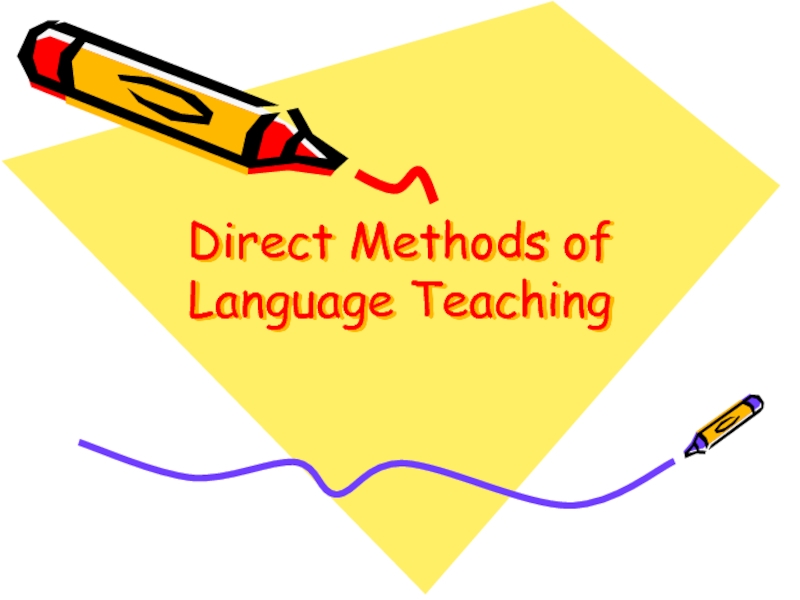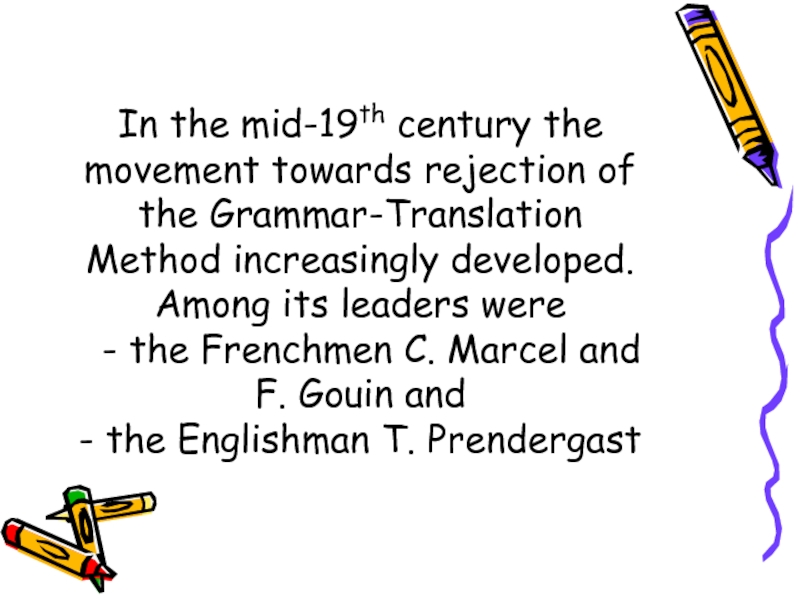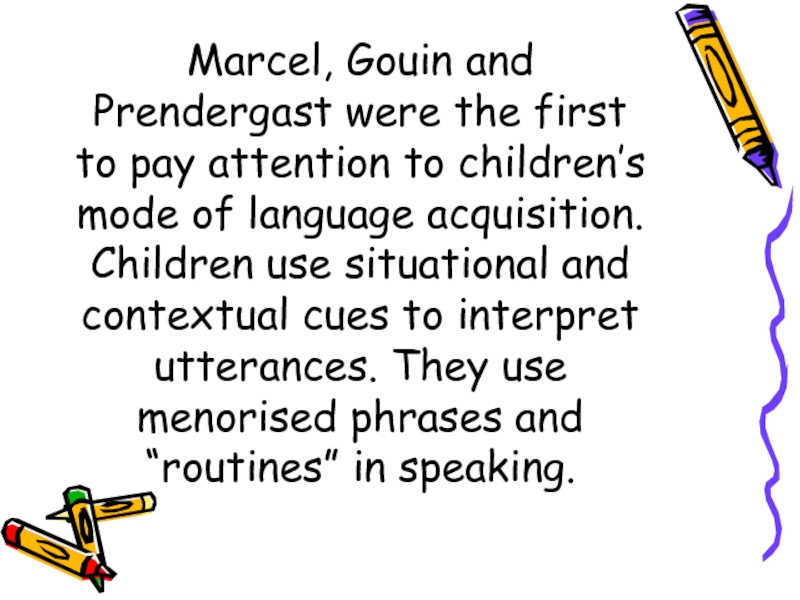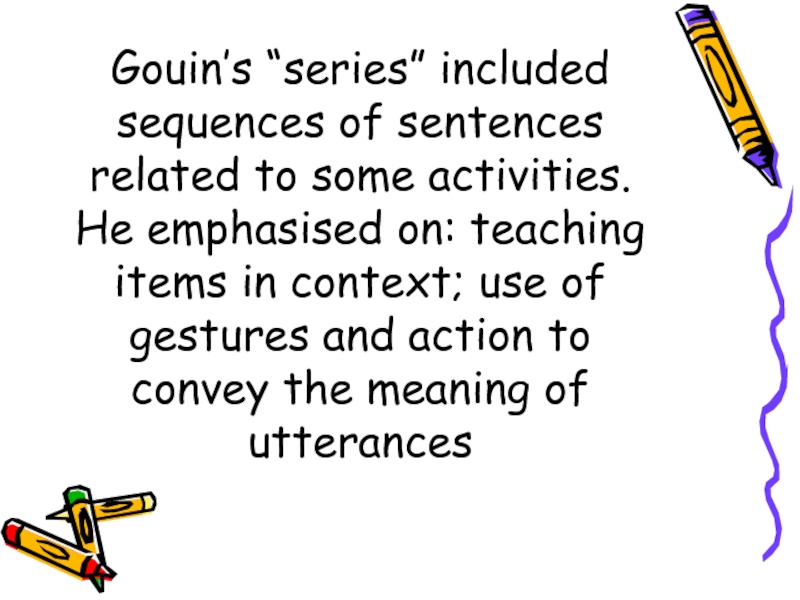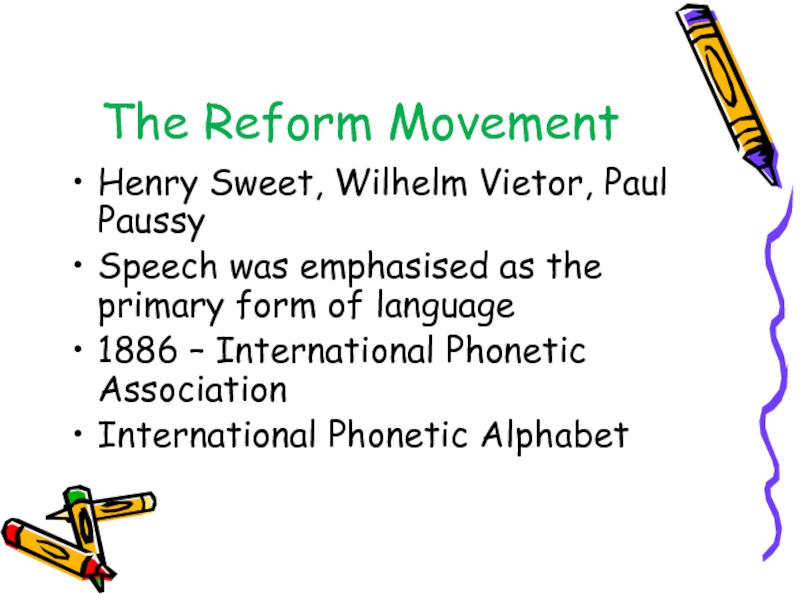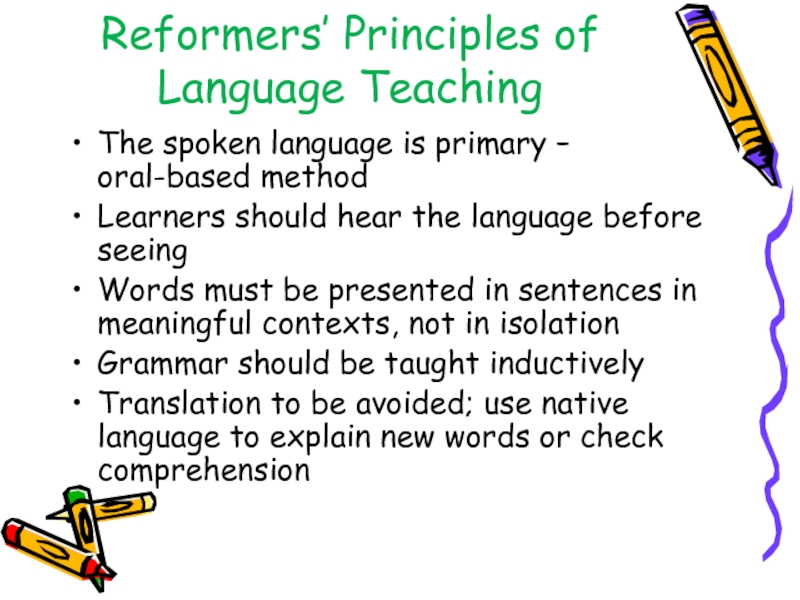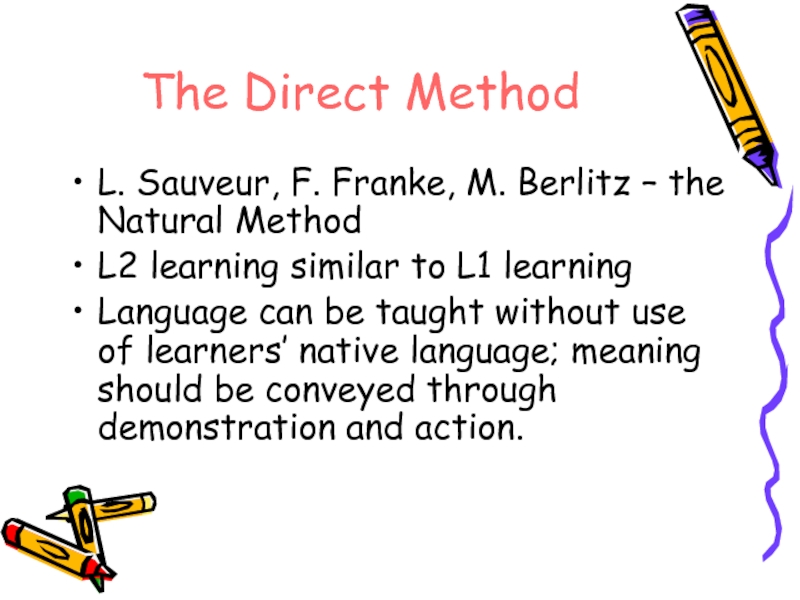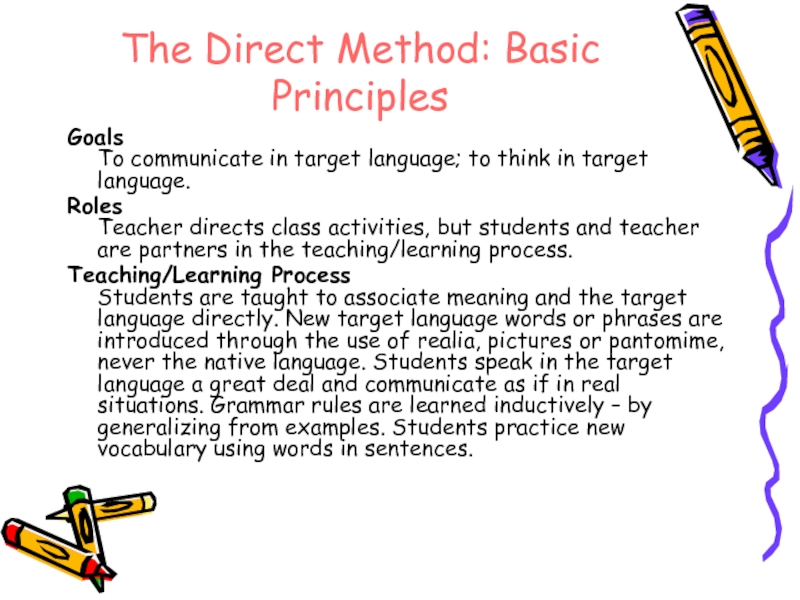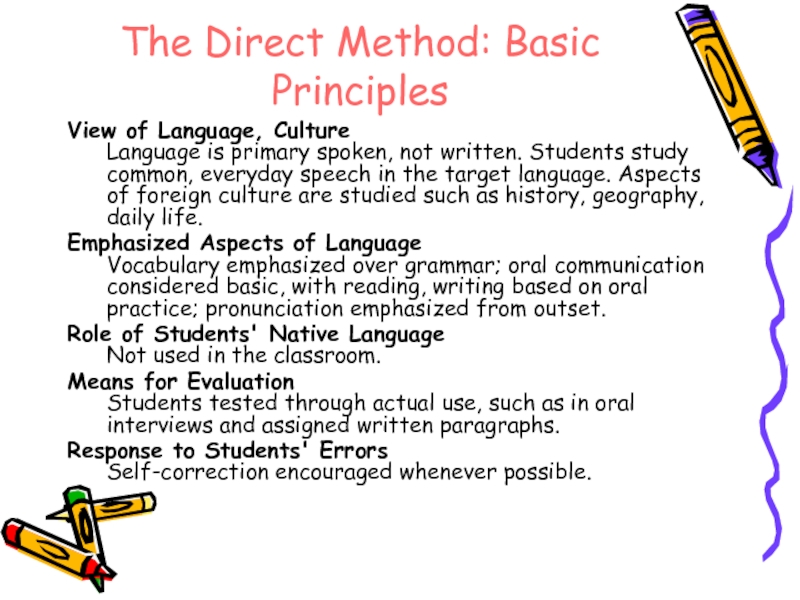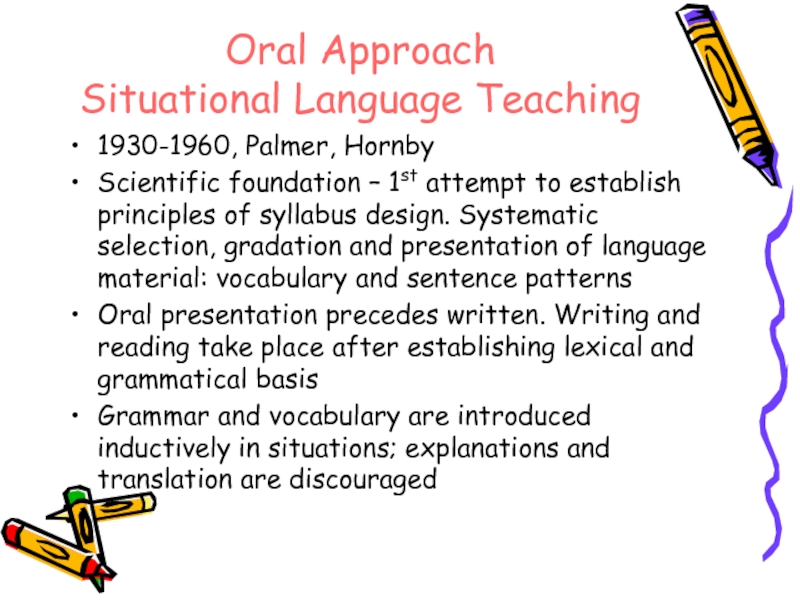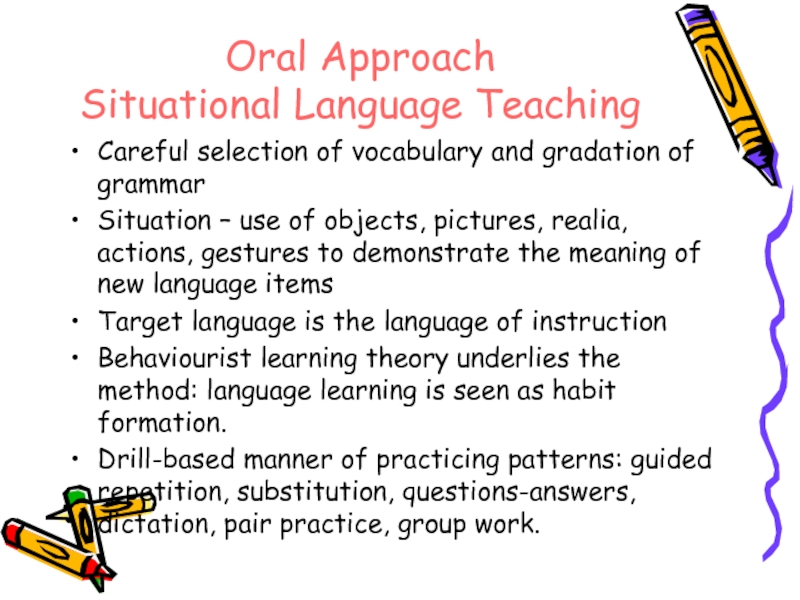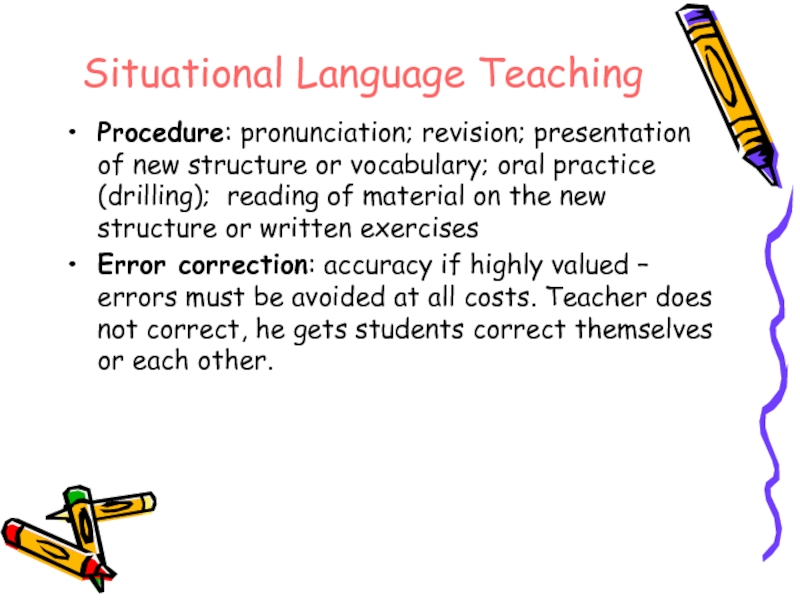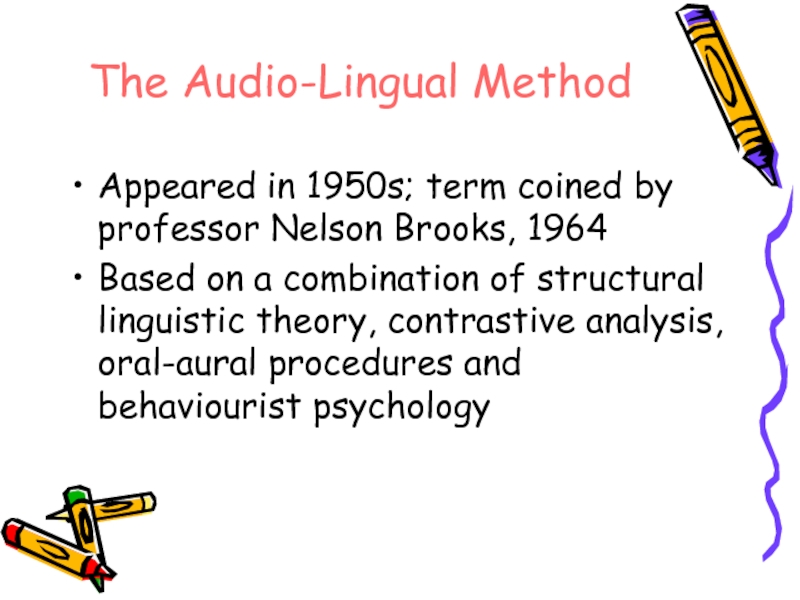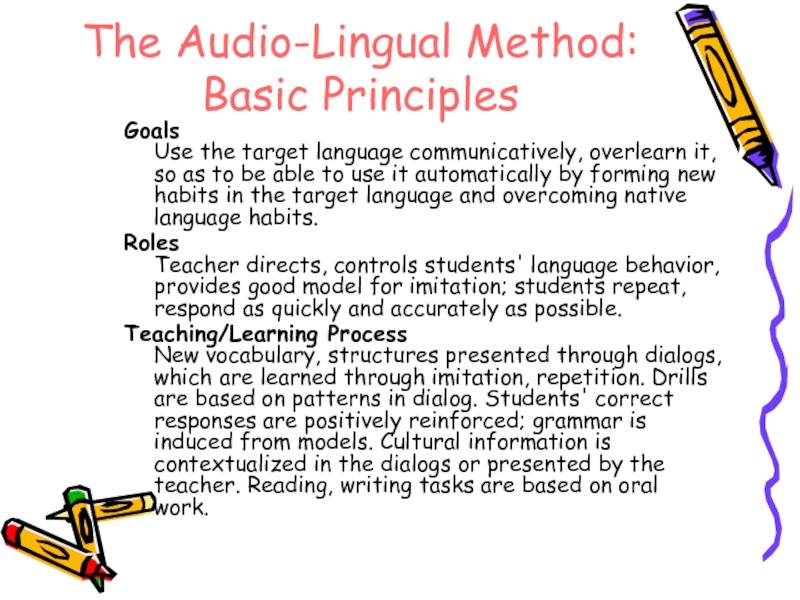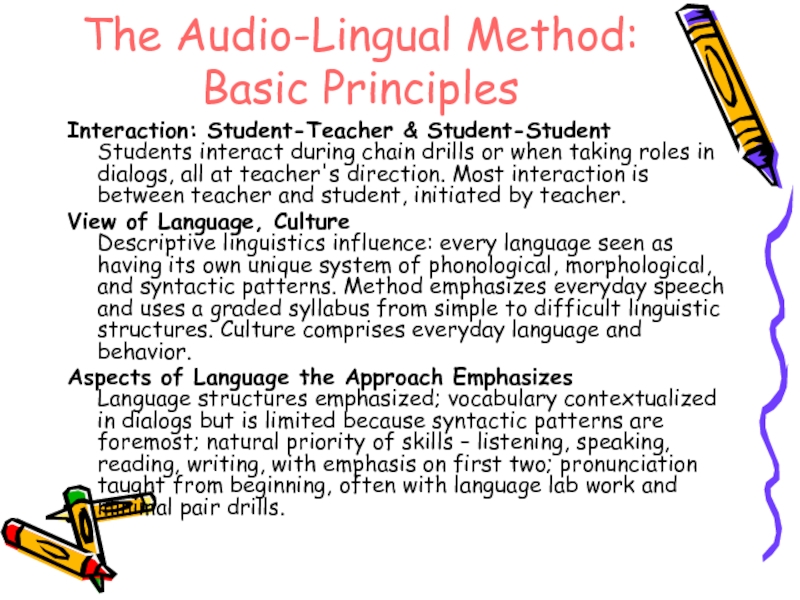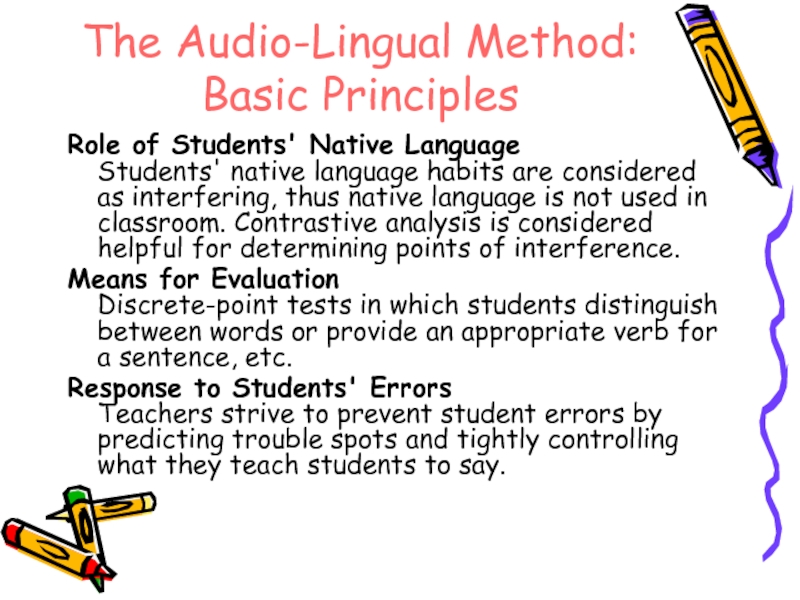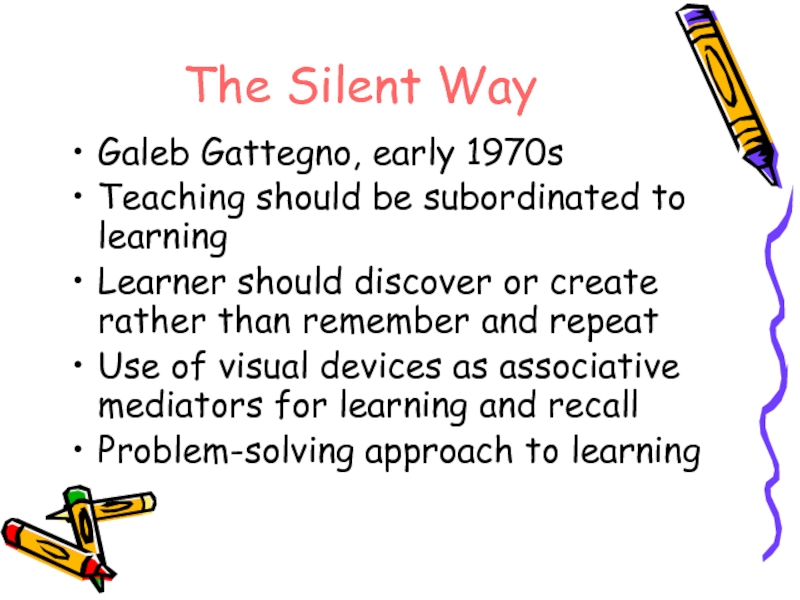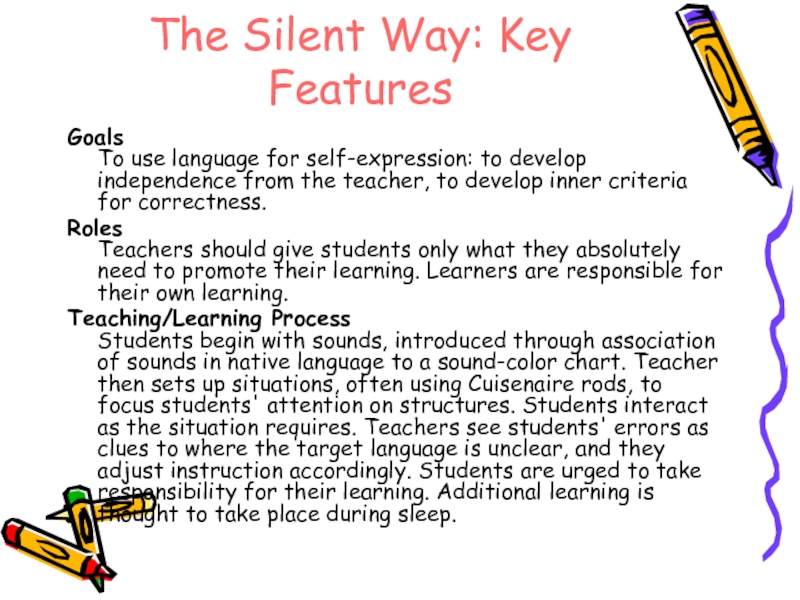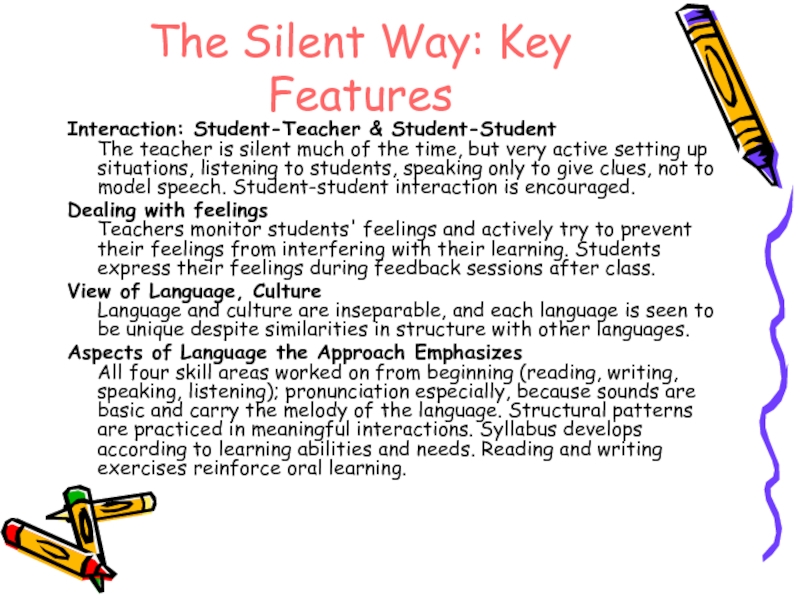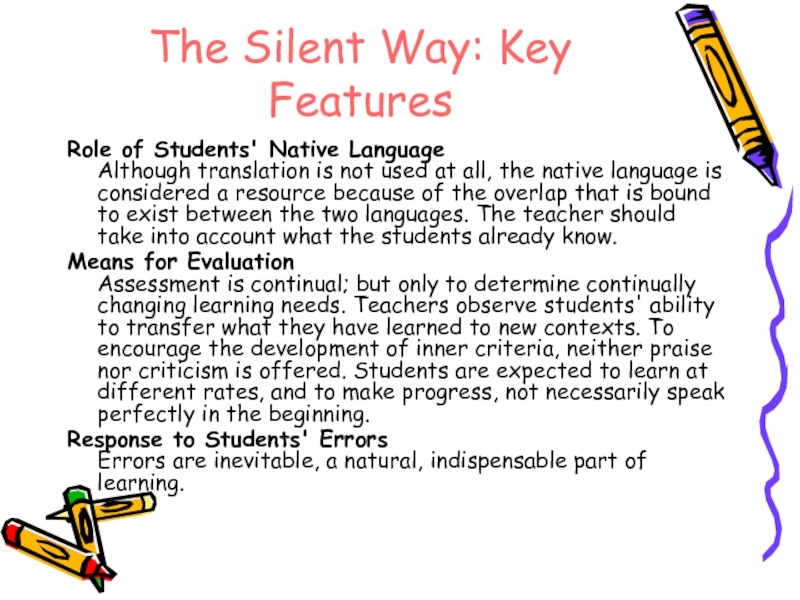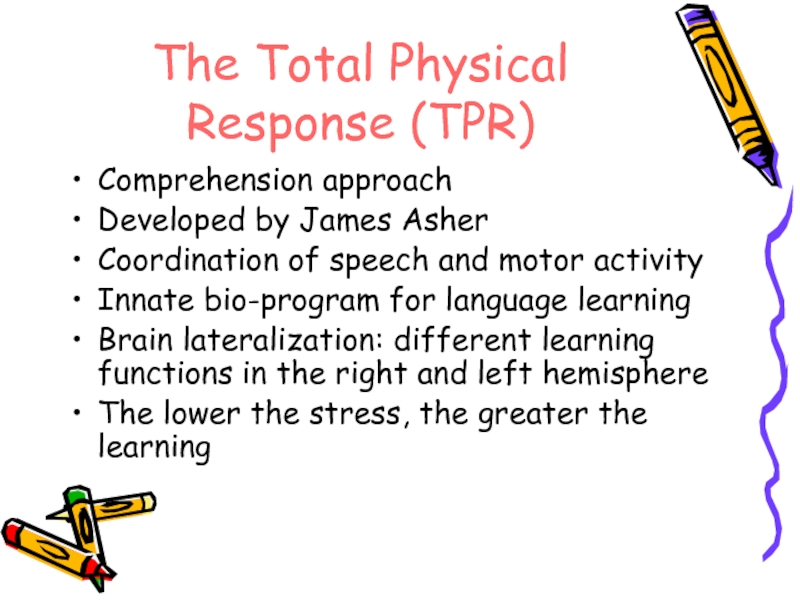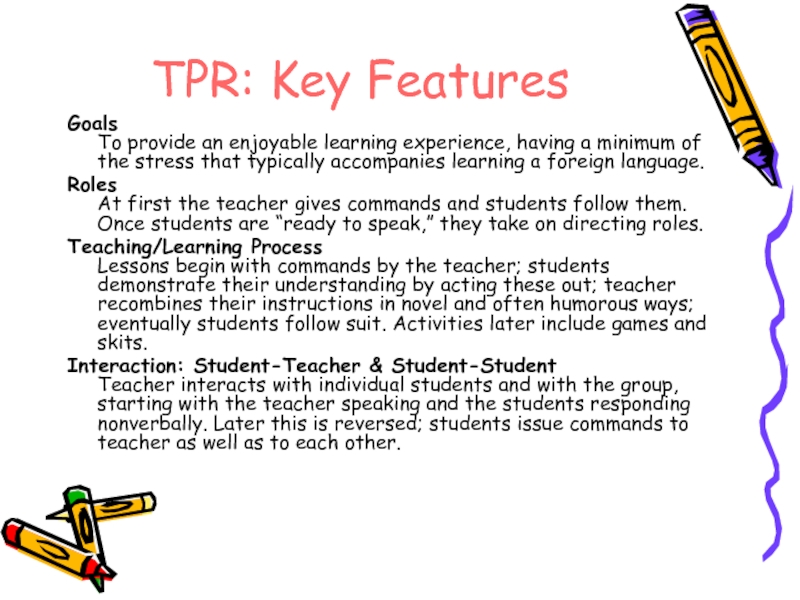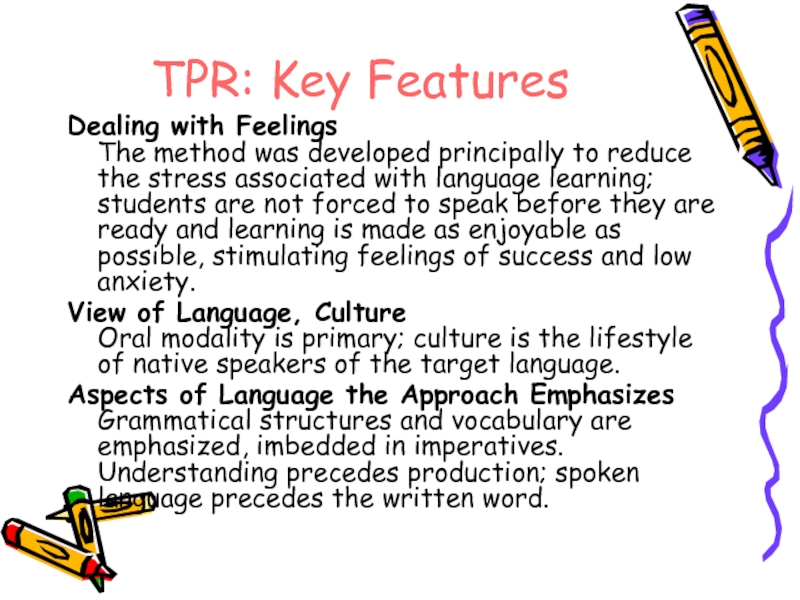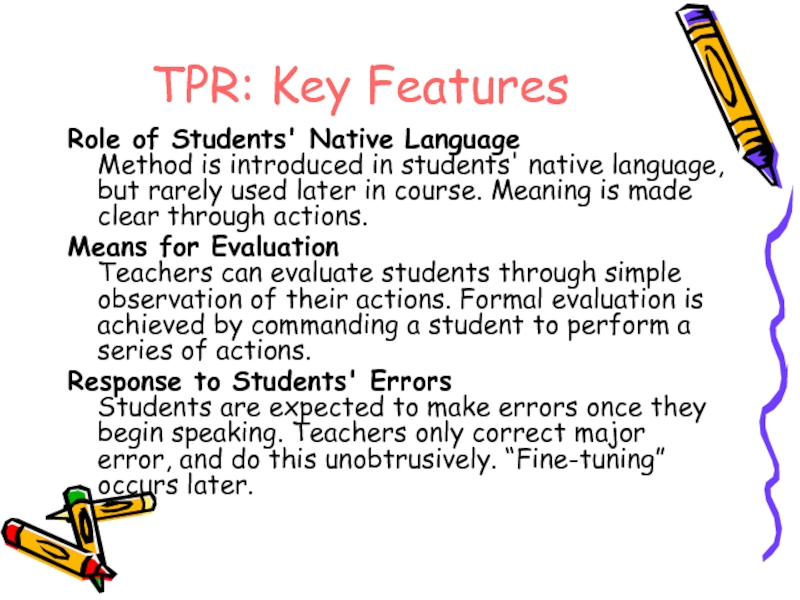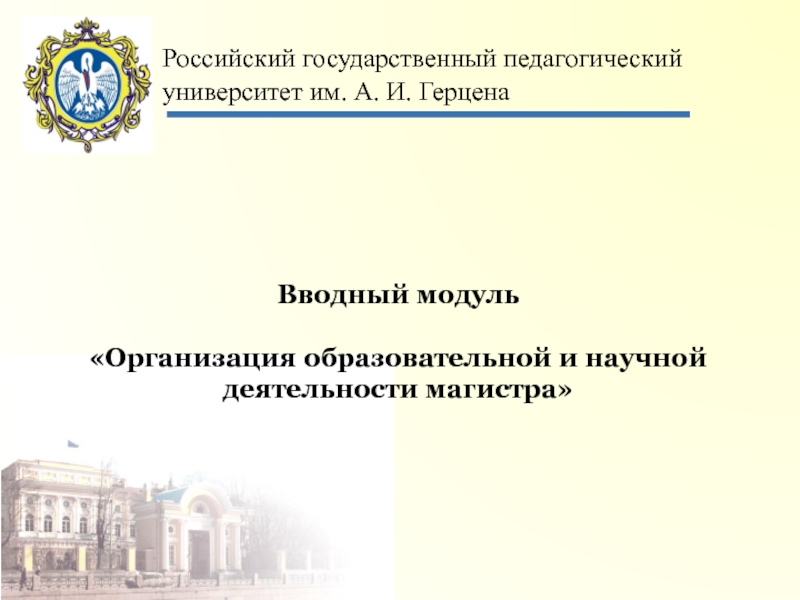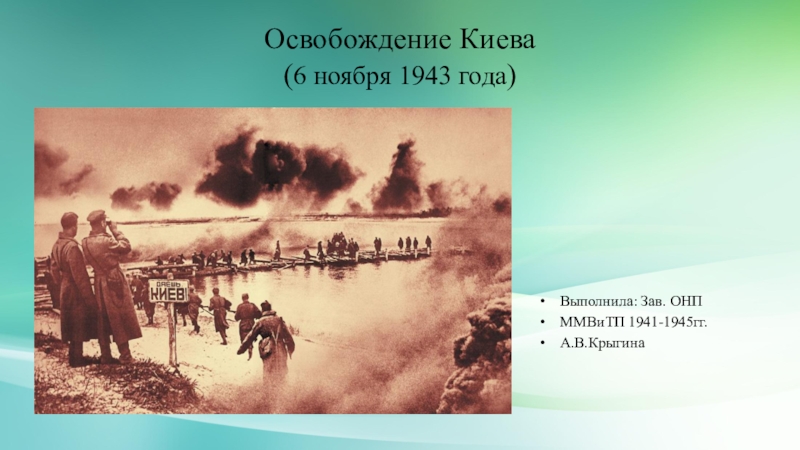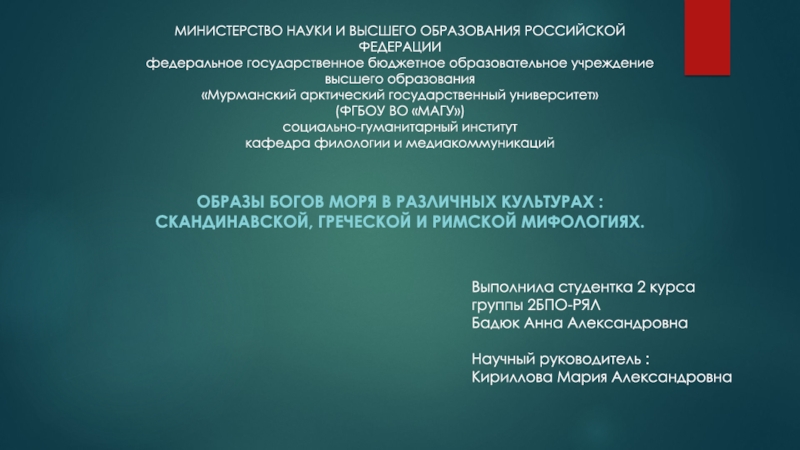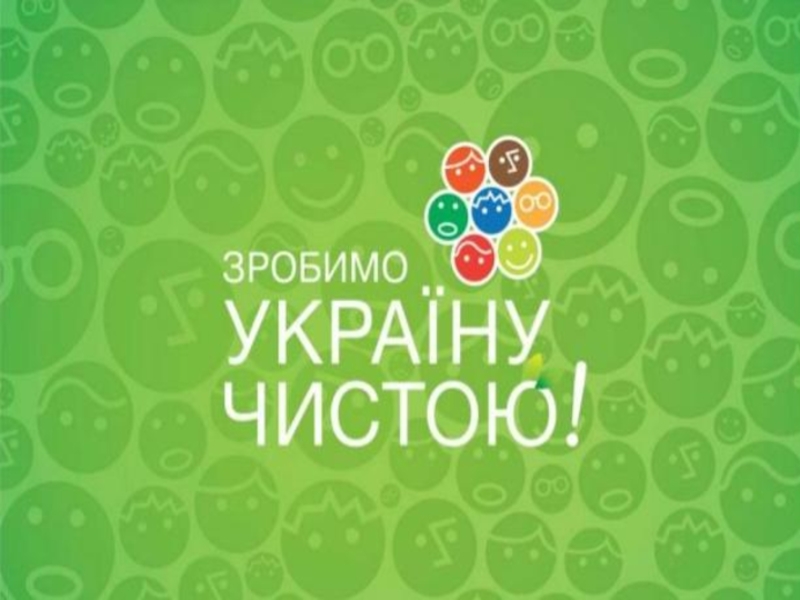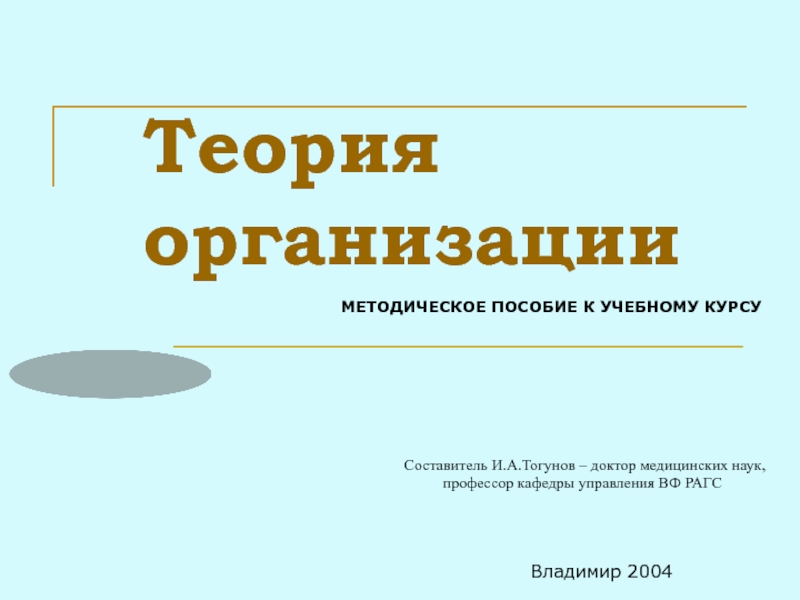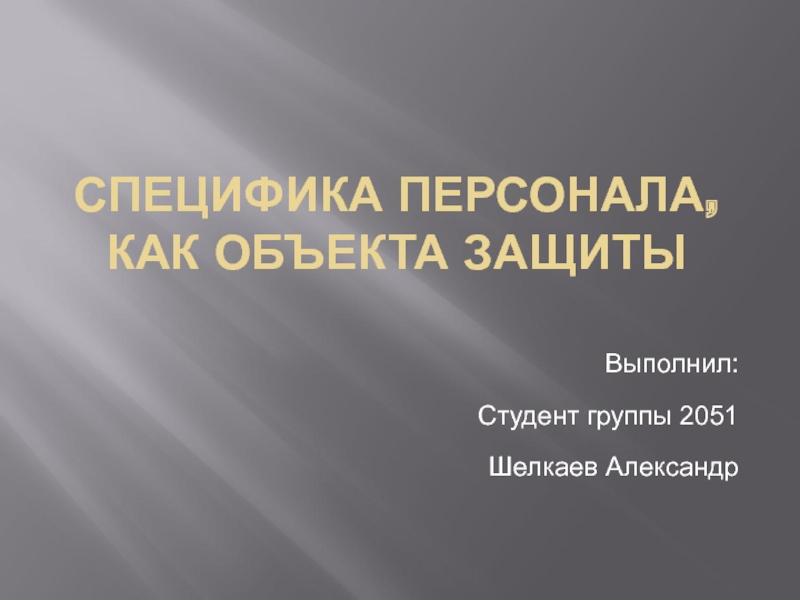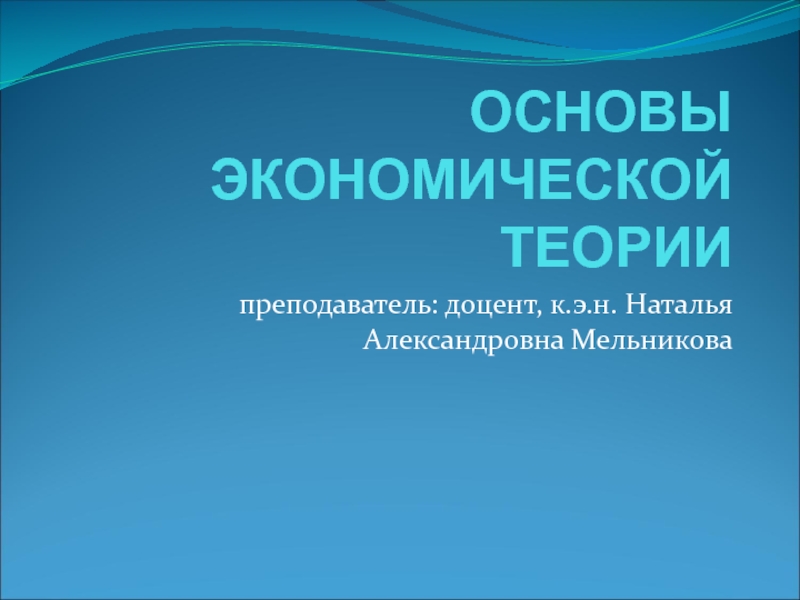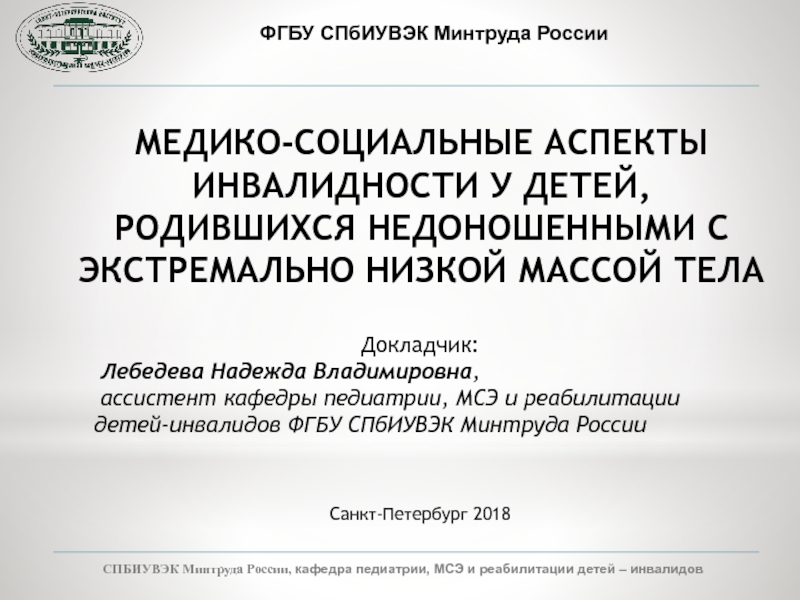Разделы презентаций
- Разное
- Английский язык
- Астрономия
- Алгебра
- Биология
- География
- Геометрия
- Детские презентации
- Информатика
- История
- Литература
- Математика
- Медицина
- Менеджмент
- Музыка
- МХК
- Немецкий язык
- ОБЖ
- Обществознание
- Окружающий мир
- Педагогика
- Русский язык
- Технология
- Физика
- Философия
- Химия
- Шаблоны, картинки для презентаций
- Экология
- Экономика
- Юриспруденция
Direct Methods of Language Teaching
Содержание
- 1. Direct Methods of Language Teaching
- 2. In the mid-19th century the movement towards
- 3. Marcel, Gouin and Prendergast were the first
- 4. Gouin’s “series” included sequences of sentences related
- 5. The Reform MovementHenry Sweet, Wilhelm Vietor, Paul
- 6. Reformers’ Principles of Language TeachingThe spoken language
- 7. The Direct MethodL. Sauveur, F. Franke, M.
- 8. The Direct Method: Basic PrinciplesGoals To communicate
- 9. The Direct Method: Basic PrinciplesView of Language,
- 10. Oral Approach Situational Language Teaching1930-1960, Palmer, Hornby
- 11. Oral Approach Situational Language TeachingCareful selection of
- 12. Situational Language TeachingTeacher-learner roles: T – model,
- 13. Situational Language TeachingProcedure: pronunciation; revision; presentation of
- 14. The Audio-Lingual MethodAppeared in 1950s; term coined
- 15. The Audio-Lingual Method: Basic PrinciplesGoals Use the
- 16. The Audio-Lingual Method: Basic PrinciplesInteraction: Student-Teacher &
- 17. The Audio-Lingual Method: Basic PrinciplesRole of Students'
- 18. The Silent WayGaleb Gattegno, early 1970sTeaching should
- 19. The Silent Way: Key FeaturesGoals To use
- 20. The Silent Way: Key FeaturesInteraction: Student-Teacher &
- 21. The Silent Way: Key FeaturesRole of Students'
- 22. The Total Physical Response (TPR)Comprehension approachDeveloped by
- 23. TPR: Key FeaturesGoals To provide an enjoyable
- 24. TPR: Key FeaturesDealing with Feelings The method
- 25. TPR: Key FeaturesRole of Students' Native Language
- 26. THANK YOU!
- 27. Скачать презентанцию
In the mid-19th century the movement towards rejection of the Grammar-Translation Method increasingly developed. Among its leaders were - the Frenchmen C. Marcel and F. Gouin and - the Englishman
Слайды и текст этой презентации
Слайд 3Marcel, Gouin and Prendergast were the first to pay attention
to children’s mode of language acquisition. Children use situational and
contextual cues to interpret utterances. They use menorised phrases and “routines” in speaking.Слайд 4Gouin’s “series” included sequences of sentences related to some activities.
He emphasised on: teaching items in context; use of gestures
and action to convey the meaning of utterancesСлайд 5The Reform Movement
Henry Sweet, Wilhelm Vietor, Paul Paussy
Speech was emphasised
as the primary form of language
1886 – International Phonetic Association
International
Phonetic AlphabetСлайд 6Reformers’ Principles of Language Teaching
The spoken language is primary –
oral-based method
Learners should hear the language before seeing
Words must be
presented in sentences in meaningful contexts, not in isolationGrammar should be taught inductively
Translation to be avoided; use native language to explain new words or check comprehension
Слайд 7The Direct Method
L. Sauveur, F. Franke, M. Berlitz – the
Natural Method
L2 learning similar to L1 learning
Language can be taught
without use of learners’ native language; meaning should be conveyed through demonstration and action.Слайд 8The Direct Method: Basic Principles
Goals
To communicate in target language; to
think in target language.
Roles
Teacher directs class activities, but students and
teacher are partners in the teaching/learning process.Teaching/Learning Process Students are taught to associate meaning and the target language directly. New target language words or phrases are introduced through the use of realia, pictures or pantomime, never the native language. Students speak in the target language a great deal and communicate as if in real situations. Grammar rules are learned inductively – by generalizing from examples. Students practice new vocabulary using words in sentences.
Слайд 9The Direct Method: Basic Principles
View of Language, Culture
Language is primary
spoken, not written. Students study common, everyday speech in the
target language. Aspects of foreign culture are studied such as history, geography, daily life.Emphasized Aspects of Language Vocabulary emphasized over grammar; oral communication considered basic, with reading, writing based on oral practice; pronunciation emphasized from outset.
Role of Students' Native Language Not used in the classroom.
Means for Evaluation Students tested through actual use, such as in oral interviews and assigned written paragraphs.
Response to Students' Errors Self-correction encouraged whenever possible.
Слайд 10Oral Approach
Situational Language Teaching
1930-1960, Palmer, Hornby
Scientific foundation – 1st
attempt to establish principles of syllabus design. Systematic selection, gradation
and presentation of language material: vocabulary and sentence patternsOral presentation precedes written. Writing and reading take place after establishing lexical and grammatical basis
Grammar and vocabulary are introduced inductively in situations; explanations and translation are discouraged
Слайд 11Oral Approach
Situational Language Teaching
Careful selection of vocabulary and gradation of
grammar
Situation – use of objects, pictures, realia, actions, gestures to
demonstrate the meaning of new language itemsTarget language is the language of instruction
Behaviourist learning theory underlies the method: language learning is seen as habit formation.
Drill-based manner of practicing patterns: guided repetition, substitution, questions-answers, dictation, pair practice, group work.
Слайд 12Situational Language Teaching
Teacher-learner roles: T – model, manipulator. Teacher-centered lessons.
L is supposed to listen and repeat
Teacher’s responsibilities: timing, oral
practice, revision, adjustment to individuals special needs, testing, developing extra language activitiesMaterials: textbook + visual aids (wall charts, flashcards, pictures, figures). Textbook – guide to learning; teacher – master of the textbook
Слайд 13Situational Language Teaching
Procedure: pronunciation; revision; presentation of new structure or
vocabulary; oral practice (drilling); reading of material on the new
structure or written exercisesError correction: accuracy if highly valued – errors must be avoided at all costs. Teacher does not correct, he gets students correct themselves or each other.
Слайд 14The Audio-Lingual Method
Appeared in 1950s; term coined by professor Nelson
Brooks, 1964
Based on a combination of structural linguistic theory, contrastive
analysis, oral-aural procedures and behaviourist psychologyСлайд 15The Audio-Lingual Method: Basic Principles
Goals
Use the target language communicatively, overlearn
it, so as to be able to use it automatically
by forming new habits in the target language and overcoming native language habits.Roles Teacher directs, controls students' language behavior, provides good model for imitation; students repeat, respond as quickly and accurately as possible.
Teaching/Learning Process New vocabulary, structures presented through dialogs, which are learned through imitation, repetition. Drills are based on patterns in dialog. Students' correct responses are positively reinforced; grammar is induced from models. Cultural information is contextualized in the dialogs or presented by the teacher. Reading, writing tasks are based on oral work.
Слайд 16The Audio-Lingual Method: Basic Principles
Interaction: Student-Teacher & Student-Student
Students interact during
chain drills or when taking roles in dialogs, all at
teacher's direction. Most interaction is between teacher and student, initiated by teacher.View of Language, Culture Descriptive linguistics influence: every language seen as having its own unique system of phonological, morphological, and syntactic patterns. Method emphasizes everyday speech and uses a graded syllabus from simple to difficult linguistic structures. Culture comprises everyday language and behavior.
Aspects of Language the Approach Emphasizes Language structures emphasized; vocabulary contextualized in dialogs but is limited because syntactic patterns are foremost; natural priority of skills – listening, speaking, reading, writing, with emphasis on first two; pronunciation taught from beginning, often with language lab work and minimal pair drills.
Слайд 17The Audio-Lingual Method: Basic Principles
Role of Students' Native Language
Students' native
language habits are considered as interfering, thus native language is
not used in classroom. Contrastive analysis is considered helpful for determining points of interference.Means for Evaluation Discrete-point tests in which students distinguish between words or provide an appropriate verb for a sentence, etc.
Response to Students' Errors Teachers strive to prevent student errors by predicting trouble spots and tightly controlling what they teach students to say.
Слайд 18The Silent Way
Galeb Gattegno, early 1970s
Teaching should be subordinated to
learning
Learner should discover or create rather than remember and repeat
Use
of visual devices as associative mediators for learning and recallProblem-solving approach to learning
Слайд 19The Silent Way: Key Features
Goals
To use language for self-expression: to
develop independence from the teacher, to develop inner criteria for
correctness.Roles Teachers should give students only what they absolutely need to promote their learning. Learners are responsible for their own learning.
Teaching/Learning Process Students begin with sounds, introduced through association of sounds in native language to a sound-color chart. Teacher then sets up situations, often using Cuisenaire rods, to focus students' attention on structures. Students interact as the situation requires. Teachers see students' errors as clues to where the target language is unclear, and they adjust instruction accordingly. Students are urged to take responsibility for their learning. Additional learning is thought to take place during sleep.
Слайд 20The Silent Way: Key Features
Interaction: Student-Teacher & Student-Student
The teacher is
silent much of the time, but very active setting up
situations, listening to students, speaking only to give clues, not to model speech. Student-student interaction is encouraged.Dealing with feelings Teachers monitor students' feelings and actively try to prevent their feelings from interfering with their learning. Students express their feelings during feedback sessions after class.
View of Language, Culture Language and culture are inseparable, and each language is seen to be unique despite similarities in structure with other languages.
Aspects of Language the Approach Emphasizes All four skill areas worked on from beginning (reading, writing, speaking, listening); pronunciation especially, because sounds are basic and carry the melody of the language. Structural patterns are practiced in meaningful interactions. Syllabus develops according to learning abilities and needs. Reading and writing exercises reinforce oral learning.
Слайд 21The Silent Way: Key Features
Role of Students' Native Language
Although translation
is not used at all, the native language is considered
a resource because of the overlap that is bound to exist between the two languages. The teacher should take into account what the students already know.Means for Evaluation Assessment is continual; but only to determine continually changing learning needs. Teachers observe students' ability to transfer what they have learned to new contexts. To encourage the development of inner criteria, neither praise nor criticism is offered. Students are expected to learn at different rates, and to make progress, not necessarily speak perfectly in the beginning.
Response to Students' Errors Errors are inevitable, a natural, indispensable part of learning.
Слайд 22The Total Physical Response (TPR)
Comprehension approach
Developed by James Asher
Coordination of
speech and motor activity
Innate bio-program for language learning
Brain lateralization: different
learning functions in the right and left hemisphereThe lower the stress, the greater the learning
Слайд 23TPR: Key Features
Goals
To provide an enjoyable learning experience, having a
minimum of the stress that typically accompanies learning a foreign
language.Roles At first the teacher gives commands and students follow them. Once students are “ready to speak,” they take on directing roles.
Teaching/Learning Process Lessons begin with commands by the teacher; students demonstrate their understanding by acting these out; teacher recombines their instructions in novel and often humorous ways; eventually students follow suit. Activities later include games and skits.
Interaction: Student-Teacher & Student-Student Teacher interacts with individual students and with the group, starting with the teacher speaking and the students responding nonverbally. Later this is reversed; students issue commands to teacher as well as to each other.
Слайд 24TPR: Key Features
Dealing with Feelings
The method was developed principally to
reduce the stress associated with language learning; students are not
forced to speak before they are ready and learning is made as enjoyable as possible, stimulating feelings of success and low anxiety.View of Language, Culture Oral modality is primary; culture is the lifestyle of native speakers of the target language.
Aspects of Language the Approach Emphasizes Grammatical structures and vocabulary are emphasized, imbedded in imperatives. Understanding precedes production; spoken language precedes the written word.
Слайд 25TPR: Key Features
Role of Students' Native Language
Method is introduced in
students' native language, but rarely used later in course. Meaning
is made clear through actions.Means for Evaluation Teachers can evaluate students through simple observation of their actions. Formal evaluation is achieved by commanding a student to perform a series of actions.
Response to Students' Errors Students are expected to make errors once they begin speaking. Teachers only correct major error, and do this unobtrusively. “Fine-tuning” occurs later.
